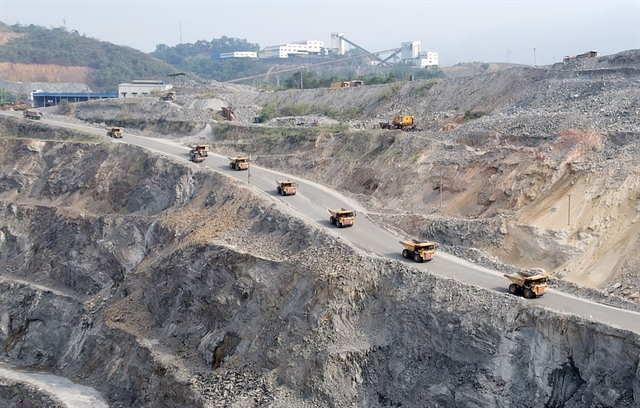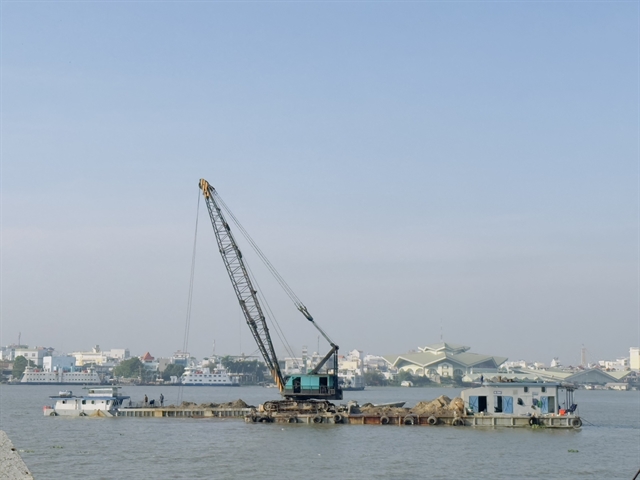Vietnam is recognized as one of the world's most biodiverse…

Amending 2010 Mineral Law a key task to effectively manage resources
According to experts, after 13 years of implementing this law, some provisions are no longer consistent with the country’s development practices, leading to the loss of mineral resources for the State.

Amending the 2010 Law on Minerals is considered a key task to address the current situation, improve the efficiency of mining management and exploitation, increase revenue for the State, and ensure a better living environment for the community and people.
According to experts, after 13 years of implementing this law, some provisions are no longer consistent with the country’s development practices, leading to the loss of mineral resources for the State.
Bui Thi An, former National Assembly deputy, former member of NA’s Committee on Science, Technology and Environment, said mining activities brought significant economic value to the country after the law took effect 13 years ago.
The State collected VN?29.6 trillion (US$1.21 billion) to the budget from issuing mineral-exploitation rights for businesses so far, she said.
She said that although the amount of money was not commensurate with the mineral resource reserves that we could exploit, the country’s management of mineral exploitation since the law took effect had been much better than before.
However, An also added that besides the positive impacts, the law has been falling short of expectations as it did not meet the practical requirements.
In terms of management, minerals were still not strictly managed at all stages. For example, the exploration and assessment of where there were mineral deposits and how much underground mineral reserves remained were not implemented effectively.
“If we explore and evaluate more effectively, determining exactly how much mineral reserves remain, we can still earn twice or three times the current amount,” she said.
In terms of mining activities, shortcomings were found. Failure to ensure technology for exploitation, such as in gold and sand mining activities, had affected people’s lives. That was an extremely consequential issue, especially for the Mekong Delta region.
She had witnessed riverbank subsidence and landslides that occurred suddenly due to exploitation, causing the loss of houses and people.
“Clearly, the impact from sand mining activities is not only on State property and money, but also on the living environment and people’s lives,” she said.
According to An, mining activities also entailed illegal mining and illegal trading. Therefore, amending the law was extremely urgent to address the situation.
“If we do not fix this law, I think we will continue to lose money and lose even bigger things,” she said.
Luu Duc Hai, chairman of Vietnam Association of Environmental Economics (VIASEE), said normally, minerals were also accompanied by other minerals. For example, lead and zinc were not found simply as these two minerals, they were also accompanied by other minerals and the content of the accompanying minerals (like gold) had higher value.
“Therefore, if the granting of mining rights is not comprehensive, it will lead to loss of mineral resources,” he said.
Although Vietnam already banned the export of raw minerals, the activity still occurred. Additionally, mining activities often did not take into account environmental damage, he said.
“Amending the law is absolutely imperative,” he added.
How to amend

Hai said the amended law had to provide more specific and clearer regulations on management, especially exploration and assessment of mineral reserves.
For example, it was necessary to specifically mention the determination of reserves and the type of static or dynamic reserves (for example, river sand belonged to dynamic type, because it could continuously drift).
Therefore, the law should clearly stipulate the issue, to avoid mineral loss, he said.
Former NA Deputy An said that one important thing for the amendment law was to specifically determine that “we did not exchange the environment for the economy”.
“For example, when receiving one VND from selling ores, we must ensure that we would not lose one VND to the environment,” she added.
She proposed that in the process of amending the law, there should be a study to divide the reasonable proportion of costs for production investment, for localities to serve social security issues and make the natural environment healthy again.
Moreover, costs for transportation infrastructure, health care and education also needed to be specifically calculated, so that people living in areas where mines were exploited could enjoy a better life, she said.
The amendment law must reflect regulations following Resolution 10-NQ/TW, issued on February 10, 2022, of the Politburo on “Strategic orientation on geology, minerals and mining industry by 2030, and vision towards 2045”.
She said that it meant ensuring social and economic development as well as protecting the environment.
Director of the People and Nature Reconciliation (PanNature) Trinh Le Nguyen said mineral resources were public assets owned by the entire people.
Thus, local people in the area that mining activities happened had the right to know specific information about the mine, what type of minerals, and who was assigned to exploit them by the State and local authorities, and what benefits the State, businesses and communities would enjoy from the mining activities, he said.
The amendment law had to clearly regulate these issues, he said.
He also mentioned the negative impacts from sand and gravel mining activities in the Hong (Red) River Delta and Mekong Delta regions. It could cause social instability, affecting the socio-economic development and lives of people and communities in related areas.
The law drafting agency was advised to offer possible options for better management of mining activities in the two regions, he said.
“I hope that the amendment law will make adjustments for more effective management,” he said.
The 2010 Law on Minerals, promulgated in November 2010, is considered an important milestone for the State management of minerals by the National Assembly.
Although the law has contributed to enhancing the effectiveness of State management and developing the mining industry, there are still inadequacies and shortcomings.
The Ministry of Natural Resources and Environment submitted to the Government to amend the law in August. The amended 2010 Law on Minerals will be called the Law on Geology and Minerals, following the Government’s Resolution 126/NQ-CP.
The draft law will consist of 13 chapters and 132 articles, creating a synchronous and unified legal corridor, ensuring transparency, overcoming inadequacies to uniformly manage the geological and mineral fields, and strictly manage and effectively use minerals.
The draft law is scheduled to be submitted to the National Assembly for first comments at the NA’s seventh plenary session in May 2024.



